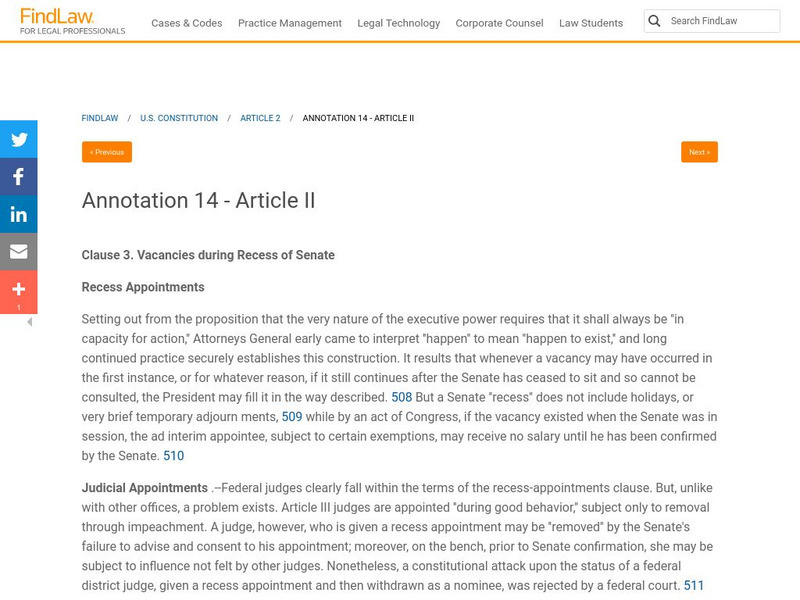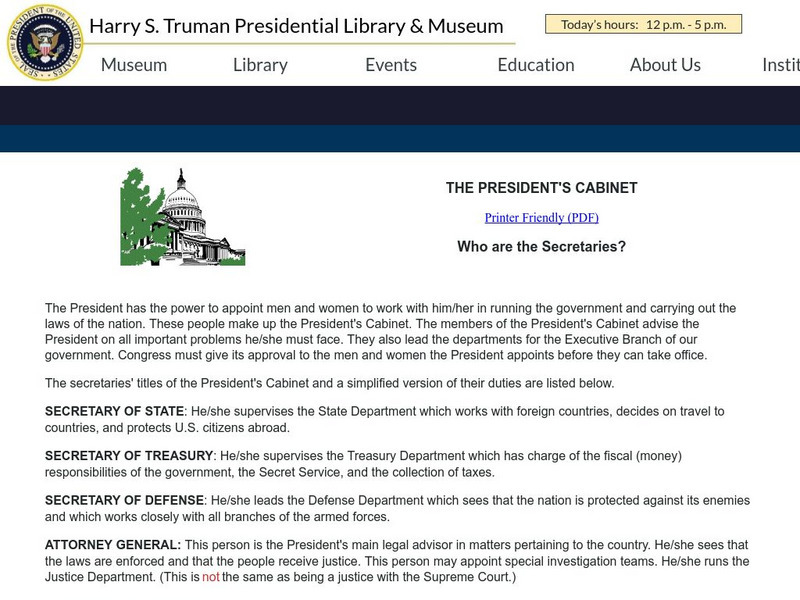Curated OER
The Election Is in the House: Was There a Corrupt Bargain?
Young scholars take a stand, supported by evidence, on whether there was a "corrupt bargain" between Henry Clay and John Quincy Adams.
Curated OER
The Monroe Doctrine: President Monroe and the Independence Movement in South America
Students identify conditions in Europe that relate to the independence movements in South America and list reasons why President Monroe gave for recognizing the independence movement in South America.
Curated OER
Elections: Ch 7
Identify the main idea, key terms, and concepts with this worksheet on US Elections. There are 5 fill in the blank and 5 multiple choice questions for your class to answer.
Curated OER
Mahoney Word Search Puzzle
In this literacy worksheet, middle schoolers look for the words that are part of the word search puzzle that is focused around the theme of the sheet.
Curated OER
Benjamin Hawkins and the Creek Indians
Eighth graders explore the settling of South Carolina. In this U.S. History instructional activity, student research the events leading to the settlement of South Carolina by the Native Americans, then discuss and answer questions...
Curated OER
Limits of Power
Middle schoolers examine the importance of limiting power in governments. In this government lesson, students investigate the importance of placing limits on government by looking at the US Constitution. They look at ways that being an...
Curated OER
What are the Qualifications to be President of the United States?
Students research the qualifications necessary to be the president of the United States. They create a want-ad for this position using what they have learned about the qualifications.
Curated OER
Dmitry Medvedev
In this famous person learning exercise, students read a passage about Dmitry Medvedev and then complete a variety of in-class and homework activities to support comprehension, including partner interviews, spelling, cloze,...
Curated OER
The Monroe Doctrine: U.S. Foreign Affairs (circa 1782-1823) and James Monroe
Students read the test of the Monroe Doctrine then list the key points and discuss its central tenets.
Curated OER
Who Gets the Job?
Students examine the Cabinet, and match Cabinet positions with current secretaries. They evaluate the qualifications of each secretary, then develop sets of qualifications for two Cabinet positions.
Curated OER
The New Deal: Domestic Policies (5)
In this online interactive American history worksheet, students answer 20 fill in the blank questions regarding the domestic policies of the New Deal. Students may submit their answers to be scored.
Curated OER
The Development of Antitrust Enforcement
Students analyze antitrust enforcement. In this American economics lesson, students listen to their instructor present a lecture regarding the details of the free market system and antitrust laws. Students respond to discussion questions...
Curated OER
The Role of the Independent Counsel
Students analyze the role of independent counsel. In this Bill of Rights lesson, students listen to their instructor present a lecture regarding Watergate, Impeachment, and the role of independent counsel. Students respond to...
Curated OER
Advise And Consent Lesson 1: Limits of Power
Young scholars examine the importance of citizens being involved in their community government for the common good. They look at the importance of limiting government and the concepts of philanthropy.
Curated OER
Founding Documents of the Peace Corps
Students examine United States foreign policy in the period immediately following World War II through the activities of the Peace Corps.
iCivics
I Civics: Mini Lesson: Presidential Appointments
Students learn about unilateral presidential appointments, nominations, and the Senate confirmation process.
Thomson Reuters
Find Law: Article Ii: Recess Appointments
Explains Clause 3 of Article II, Vacancies during Recess of Senate. It outlines various situations where a vacancy may occur and what rules are in place to deal with it.
Other
Broadcasting Board of Governors
Promoting reliable and balanced journalism, the Broadcasting Board of Governors provides a comprehensive history, goal-set and ongoing intentions for international public broadcasting. The BBG seeks to provide unbiased and uncensored...
Harp Week
The Presidential Elections 1860 1912: James A. Garfield
This biography of James A. Garfield covers his participation in the Civil War, terms in the House of Representatives, and tumultous time in the presidency, serving only four months before he was shot by a would-be assassin.
PBS
Pbs: The President's Cabinet: Choosing the Right Members (Lesson Plan)
A lesson that involves students in explaining the confirmation process of presidential appointees by testing the system of checks and balances and the separation of powers. The lesson also requires students to simulate the confirmation...
Harry S. Truman Library and Museum
Harry S. Truman Library: The President's Cabinet
Features a teacher-directed activity that explores the President's Cabinet and the duties of each secretary.
PBS
Pbs News Hour: Supreme Court Confirmation Simulation (Lesson Plan)
A lesson that engages learners in a simulation exploring the fundamental roles of the executive branch and the Senate in the judicial selection process. Students will participate in a mock judicial hearing to confirm a Supreme Court...
PBS
Pbs Teachers: Advice and Consent: Supreme Court Nominations (Lesson Plan)
A lesson that explains the role of checks and balances in U.S. system of government. Students will describe the process of selecting justices for the Supreme Court, will examine past Supreme Court cases, and will discuss how the Supreme...
A&E Television
History.com: How John Marshall Expanded the Power of the Supreme Court
When John Marshall was appointed chief justice of the U.S. Supreme Court in 1801, the nation's highest court occupied a lowly position. There was no Supreme Court Building in the newly completed capital, Washington, D.C., so the six...




















